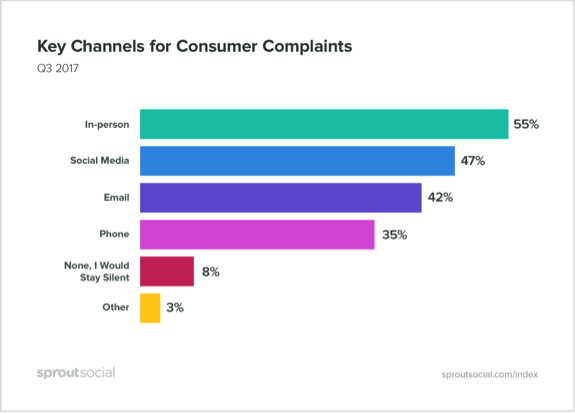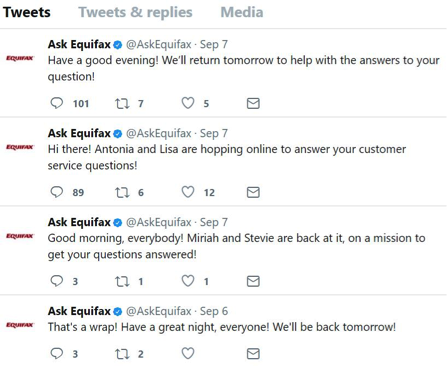By adaptive - October 10th, 2017
Tweeting, texting or calling? It should be the consumer's choice—not the company's. Susan Kuchinskas reports on how businesses need to change the customer service game plan to include social media.
In September, Equifax pretty much owned #customerservice #fail. The data breach itself was horrendous—but that's happened to plenty of other major brands. The company's response was what really hurt it.
First, Equifax asked consumers to waive their rights to sue before they could check whether their personal data had been stolen. The pushback on social media was intense, with people calling into question the company’s entire business model. Equifax backed off on that one, but its attempts to provide customer service via social media were an even bigger fail.
Equifax's main Twitter account, @Equifax, simply directed consumers with concerns to a special website set up to address the breach. Oops, there was a problem with that, too. Someone on the social media team sent links to the wrong website, according to The Verge: Instead of equifaxsecurity2017.com, some tweets sent people to securityequifax2017.com. Luckily, the latter site was set up not by a scammer, but by a white-hat developer.
Nick Sweeting told The Verge, "I made [securityequifax2017.com] because Equifax made a huge mistake by using a domain that doesn't have any trust attached to it [as opposed to hosting it on equifax.com]."
So, no harm but a big foul on that one.
Tool for good or ill
Mistakes like this live on and on in social media—and often, they're amplified. The Q3 2017 Sprout Social Index found that 46 percent of consumers have used social to "call out" brands they perceive as behaving badly. They're most likely to take to social media to complain about dishonesty, bad customer service, and rudeness—especially rudeness in the real world, as opposed to online.
Sprout also found that, after an in-person complaint, social media was the top channel for consumers to express their displeasure:

Social media fails
Equifax's response to its data breach illustrates these customer-service mistakes:
Single channel for service:Although Equifax has a Facebook Page and two Twitter accounts, they all basically direct consumers to the website. But consumers expect to be able to connect with brands using their preferred channels, according to the 2017 Customer Service Expectations Survey by Gladly, provider of an omnichannel customer service platform. Its consumer survey found that consumers use an average of three different communication channels to interact with companies.
Going dark: On September 7, the day Equifax announced that some 143 million U.S. consumers might have been affected by the data breach, customer service reps were not available day and night.

Meeting customers where they are
Some brands need to shift their entire approach to customer service, according to Blake Morgan, author of More is More: How the Best Companies Work Harder and Go Farther to Create Knock Your Socks Off Customer Experiences.
She says, "Great customer experiences make customers' lives easier and better. For many years, brands have gotten away with making things hard on customers to make it easier on themselves. Successful brands make it harder on themselves."
That means being willing to handle customer issues on multiple channels—chat, text, and multiple social platforms. Morgan points to Apple, 1-800-Flowers and JackThreads as examples of excellent, multichannel customer service. She noted that Apple embeds its how-to videos into tweets, while 1-800-Flowers was one of the first to build a chatbot on Facebook.
In fact, Facebook is becoming more important for customer service, thanks to the Bots on Messenger platform, opened to companies in April 2016.
Multiple channels, multiple tickets
The problem with providing multichannel customer service is that many companies are stuck with using a different set of tools for each channel, with no way to integrate data from different communications, according to Jenny Roy, vice president of marketing for Gladly, a company that provides a unified customer service platform.
To make the job more difficult, she notes that people often use multiple channels to communicate the same issue. "If I really want my issue resolved, I might call, email and send a tweet. If I don't get a response quick enough, I might change channels," she says.
For many companies, that call, email and tweet initiate three different tickets, which might be responded to by three different people.
In addition to technological solutions, there needs to be an organizational change, according to Morgan. "Many modern companies have blended teams of agents who can transact on a variety of different channels. It's not like one person sits on Twitter all day," she says.
A case in point is JetBlue, long admired for customer service. It's stepped up its game by moving to Gladly's multichannel software platform and making a strategic investment in the company.
JetBlue claims that once the software is up and running, the airline’s customers will be able to have continuous, real-time conversations through whichever channel they prefer at the moment.
For example, someone might tweet that they're looking forward to a vacation, adding the JetBlue hashtag. If she gets stuck in traffic on the way to the airport, she could text JetBlue that she might miss her flight.
A JetBlue customer service rep could see not only her text but also that initial tweet, providing context about the situation. The rep could text back some rebooking options and then send an email confirmation of the new booking, all while that customer is still grinding through the gridlock.
It's important to note that, despite the continuing expansion of social media usage, phone calls remain an important customer-service channel. Gladly's survey found that, for time-sensitive requests, social media was the least-preferred option. In those cases, 81 percent of respondents selected phone support as their first or second choice for resolution.
It's worth it to get customer service right on social media: An excellent response to a complaint via social media can win back a customer. Sprout Social found that, following a callout or reading negative reviews on social media, 44 percent of people would buy again from the brand if the brand responded well—and social media is often the best way to do that.

